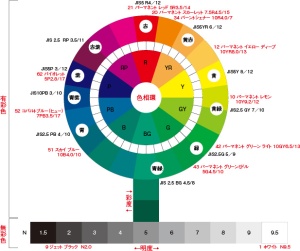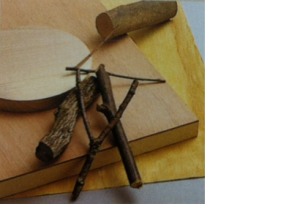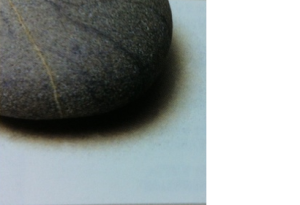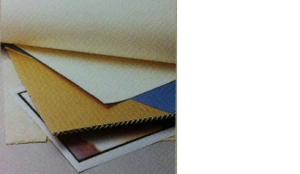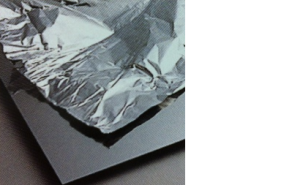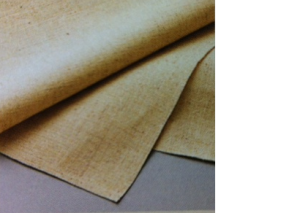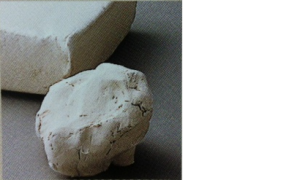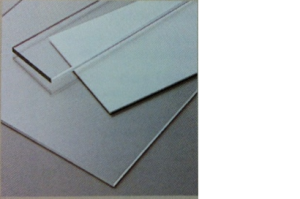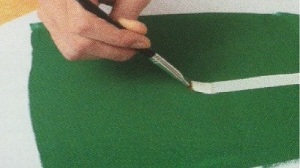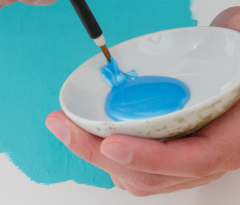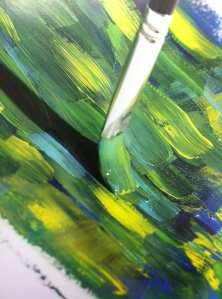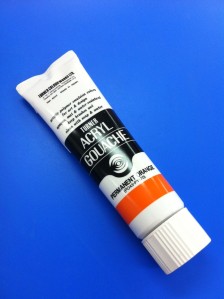Munsell color system
*Color Specification and Color Mixing*
Since color specifications by the Munsell Notation System are printed on Acryl Gouache, you can mix colors or arrange color schemes logically and effectively without depending on experience or intuition. All the colors of Acryl Gouache can be mixed each other.
In order to maintain brilliance of colors, colors near in hue should be mixed: for example, when you want yellowish red, you should mix red with orange instead of mixing red with yellow. On the other hand, when you want dull colors, colors far in hue or achromatic colors, i.e., white, black or gray are appropriate to decrease brilliance of colors. Burnt Sienna is sometimes used as a basic color for color mixing but as Burnt Sienna of Acryl Gouache has a high tinting strength, you should mix it with other colors gradually and carefully in order to obtain the color you need.
MUNSELL COLOR SYSTEM
Longevity
*Durability*
Cracking or Peeling would rarely occur even when the works in Acryl Gouache are rolled up, but cracking may occur if they are folded back. Films of Acryl Gouache are not so flexible as acrylic colors. Rubbing or scratching resistance is not high as well. Extremely thick paintings or built up textures should be avoided.
In order to increase film strength, mix Acryl Gouache with acryl gloss varnish or gloss medium. When Acryl Gouache is mixed with those mediums, the color could change a little in its tone or could become a little transparent.
Example of tests occured with Mixing Violet color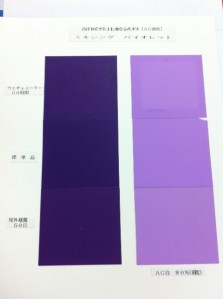
upper part->weather meter (xenon light) 50 hours
center->standard
lower part->outside 50 hours
Lightfastness
*Lightfastness*
Acryl Gouache is intended for indoor design works and is not applicable to long term outdoor usage such as mural paintings. In order to attain brilliance of color, some colors of Acryl Gouache contain pigments which are not lightfast enough. Although those pigments are especially weak against ultra-violet light, they do not fade out so rapidly under normal indoor conditions. However, for the works which are intended to be kept over a long-term period, those colors that are not lightfast enough must be avoided.
-Colors that are not lightfast enough;
aubergine
blue violet
deep purple
magenta
opera red
red violet
rose
violet
Adhesiveness
*Adhesive Properties*
Those substrates that are suitable for acrylic colors are also good for Acryl Gouache. However, because of pigment-rich formulations, the adhesive power of Acryl Gouache is not quite that high as is in acrylic colors. Acryl Gouache as well as acrylic colors do not adhere completely on those plastics such as polyethylene, polypropylene or nylon.
WOOD
STONE
PAPER
METAL
CLOTH
CLAY
ACRYL BOARD
Paintability
*Paintability of Acryl Gouache*
Acryl Gouache can be painted smoothly and uniformly without brush strokes. Finished surfaces are as uniform as those of gouache paints or even more. The amount of water to be added is similar to that of gouache paints, about half part water to one part paint. When you wish to paint very uniformly, more water should be added (until about the same quantity as that of the paint). In this case, some colors would be a little transparent but the second coat will attain complete opacity.
Water-resistance
Just like acrylic colors, Acryl Gouache is water-resistant after drying and you can paint over it easily. However, as the binder (acrylic emulsion) content is less than in acrylic colors, some colors would lose water-resistance if they are extremely thinned with water such as with a ratio of more than 2 parts water to one part paint. Care must be taken when you paint the color on non-water-permeable substrates. It is also unavoidable that if you rub the surface such as with “wet fingers”, some colors would be somewhat removed or the surface would be damaged. When you wish to thin more than usual and to obtain a waterproof surface at the same time, mix Acryl Gouache with a small amount of acrylic gloss varnish or gloss medium when you thin the paint with water.
Quick drying
<Components of Acryl Gouache>
Basically, the components of Acryl Gouache are the same as acrylic colors, pigments, acrylic emulsion and water as a thinner. But to achieve matte and opaque effects, the ratio of pigments to emulsion is higher than acrylic colors, which also enables them to produce brilliant color.
In addition, the main purpose of Acryl Gouache is for design works, coating rather than painting, so thickening agents are at a lower level than in acrylic colors and those agents that have good flow properties are used.
<Advice for Painting>
Since Acryl Gouache contains more pigments than acrylic colors, some of the properties are different.
*Quick Drying*
Since Acryl Gouache is a pigment-rich-formulated paint, it dries quicker than acrylic colors and also dries to a hard film which is sometimes more difficult to remove than acrylic colors.
Accordingly, brushes and palettes must be kept wet.
A brief introduction to Acryl Gouache
More than 60 years have passed since acrylic artists’ colors were developed in the 1950’s in the United States.
During those days, acrylic colors influenced artists’ materials in such a way that they distinguished periods as the “pre-acrylics” and “post-acrylics”. “Acryl Gouache”, which was developed in a new period of acrylics, is a new type of matte and opaque acrylic paint with enhanced flow properties and brilliance of color.
<Background of Acryl Gouache>
Although acrylic colors are so versatile that they have been employed in a far broader range than any other mediums, they are still not perfect. Despite their versatilities, acrylic colors essentially don’t have matte or opaque properties that are very common for gouache paints.
When you want opacity or to make underpaintings in your works by acrylic colors, you have to apply many layers again and again. After you paint so many layers, the surface would become so slippery that overpainting would be quite difficult. Or when a matte effect is desired, you would have to thin acrylic colors with “matte medium” or coat your work with a layer of “matte varnish”.
However, the effect of those mediums are obtained by “flatting agents” such as silica, and their effects are essentially different from the matteness of gouache paints, which is obtained by pigments.
On the other hand, for gouache paints, since they are not waterproof after drying, they are difficult to paint over on gouache paintings.
Gouache paints stick onto only porous substrates such as papers since their adhesive properties are poor compared with other materials such as acrylic colors or oil colors.
In addition, you have to be careful when carrying or preserving gouache paintings since they are weak against abrasion or scratching.
Under these limited circumstances, it might be acceptable to have an idea such as “Gouache which can be used as easily as acrylic colors” or “Gouache which can be easily combined with acrylic colors”.
That’s how Turner Colour Works Ltd created acryl gouache in Japan in 1982!
